Popular categories
Looking for a yarn?

100% Alpaca
from 3.40 £ /50g
Order DROPS Needles & Hooks
Clicking the ORDER button will redirect you to Wool Warehouse Direct Ltd website
The yarn cost is calculated from the pattern’s smallest size and the yarn’s cheapest product type. Looking for an even better price? You might find it on the DROPS Deals!
Summer Patchwork
Crochet DROPS jacket with ¾ sleeves and granny squares in ”Alpaca”. Size: S - XXXL
DROPS design: Pattern no z-643
--------------------------------------------------------
Size: XS/S - M - L/XL - XXL - XXXL
Materials:
DROPS ALPACA from Garnstudio
150-200-200-250-250 g colour no 0100, off white
50-100-100-100-100 g colour no 6205, light blue
50-100-100-100-100 g colour no 7300, lime
50-50-50-100-100 g colour no 2921, pink
50-50-50-100-100 g colour no 3140, light pink
50-50-50-100-100 g colour no 3770, dark pink
50-50-50-50-50 g colour no 2915, orange
50-50-50-50-50 g colour no 2923, goldenrod
50-50-50-50-50 g colour no 6347, grey purple
DROPS CROCHET HOOK SIZE 3 mm – or size needed to get 1 square = 6.5 x 6.5 cm. When working tr; approx. 23 tr x 12 rows = 10 x 10 cm.
-------------------------------------------------------
Alternative Yarn – See how to change yarns here
Yarn Groups A to F – Use the same pattern and change the yarn here
Yarn usage using an alternative yarn – Use our yarn converter here
-------------------------------------------------------

100% Alpaca
from 3.40 £ /50g
Order DROPS Needles & Hooks
Clicking the ORDER button will redirect you to Wool Warehouse Direct Ltd website
The yarn cost is calculated from the pattern’s smallest size and the yarn’s cheapest product type. Looking for an even better price? You might find it on the DROPS Deals!
- English (UK/cm)
- Česky
- Dansk
- Deutsch
- Eesti keel
- English (US/in)
- Español
- Français
- Íslenska
- Italiano
- Magyar
- Nederlands
- Norsk
- Polski
- Português
- Suomi
- Svenska
- English (UK/cm), Bulgaria
- English (UK/cm), Croatia
- English (UK/cm), Greece
- English (UK/cm), Latvia
- English (UK/cm), Lithuania
- English (UK/cm), Romania
- English (UK/cm), Slovenia
- Česky, Slovakia
Pattern instructions
Last round (= colour 4) on all squares is off white.
SQUARE A: Colour 1 = lime, colour 2 = orange, colour 3 = light blue.
SQUARE B: Colour 1 = goldenrod, colour 2 = light pink, colour 3 = dark pink.
SQUARE C: Colour 1 = light blue, colour 2 = lime, colour 3 = orange.
SQUARE D: Colour 1 = dark pink, colour 2 = light pink, colour 3 = lime.
SQUARE E: Colour 1 = light pink, colour 2 = pink, colour 3 = goldenrod.
SQUARE F: Colour 1 = pink, colour 2 = grey purple, colour 3 = light blue.
SQUARE G: Colour 1 = grey purple, colour 2 = light blue, colour 3 = light pink.
SQUARE H: Colour 1 = pink, colour 2 = grey purple, colour 3 = lime.
SQUARE I: Colour 1 = orange, colour 2 = goldenrod, colour 3 = dark pink.
SQUARE J: Colour 1 = light blue, colour 2 = lime, colour 3 = pink.
GRANNY SQUARE:
Crochet 6 ch on hook size 3 mm with colour 1 and form a ring with 1 sl st in first ch.
ROUND 1 (colour 1):
3 ch, 2 tr in ch-ring, * 3 ch, 3 tr in ch-ring *, repeat from *-* a total of 3 times and finish with 3 ch and 1 sl st in 3rd ch from beg of round. Turn piece.
ROUND 2 (colour 2):
3 ch, 2 tr in first ch-loop, 3 ch, 3 tr in same ch-loop, * 1 ch, 3 tr in next ch-loop, 3 ch, 3 tr in same ch-loop *, repeat from *-* a total of 3 times and finish with 1 ch and 1 sl st in 3rd ch from beg of round. Turn piece.
ROUND 3 (colour 3):
3 ch, 2 tr in first ch-loop, 1 ch, * 3 tr in next ch-loop, 3 ch, 3 tr in same ch-loop, 1 ch, 3 tr in next ch-loop, 1 ch *, repeat from *-* a total of 3 times, 3 tr in next ch-loop, 3 ch, 3 tr in same ch-loop, 1 ch and finish with 1 sl st in 3rd ch from beg of round. Turn piece.
ROUND 4 (colour 4):
3 ch, 2 tr in first ch-loop, 1 ch, * 3 tr in next ch-loop, 3 ch, 3 tr in same ch-loop, 1 ch, 3 tr in next ch-loop, 1 ch, 3 tr in next ch-loop, 1 ch *, repeat from *-* a total of 3 times, 3 tr in next ch-loop, 3 ch, 3 tr in same ch-loop, 1 ch, 3 tr in next ch-loop, 1 ch and finish with 1 sl st in 3rd ch from beg of round. Cut the thread.
1 square measures approx. 6.5 x 6.5 cm.
Work 12-14-15-20-21 squares of every colour combination, work in addition 0-2-2-8-8 extra squares (choose your own colour combination on these squares) = 120-142-152-208-218 squares in total.
SLEEVE GUSSET:
Work a piece with tr shaped as a gusset to be sewn under sleeve so it is wider at the top than the at bottom. Replace first tr on every row with 3 ch.
Work 7-8-8-8-8 ch on hook size 3 mm with off white. Turn and work 1 tr in 4th ch from hook, then work 1 tr in the remaining 3-4-4-4-4 ch = 5-6-6-6-6 tr. Continue back and forth with 1 tr in every tr until piece measures 10 cm.
READ ALL OF THE FOLLOWING SECTION BEFORE FINISHING!
On next row inc 1 tr in each side by working 2 tr in next to last tr in each side. Repeat inc every 3-2-2-2-2 rows a total of 9-12-12-12-12 times. NOTE: In size XS/S continue with 1 tr in every tr until piece measures 33 cm. In sizes M and XXL divide the piece in the middle when it measures 30 cm, then work each side separately with 1 tr in every tr until piece measures 33 cm. In sizes L/XL and XXXL divide the piece in the middle when it measures 26 cm, then work each side separately, when inc is done, with 1 tr in every tr until piece measures 33 cm.
The piece is divided in the 4 largest sizes because of dec for armholes. This is not done in the smallest size.
Work another sleeve gusset.
Place the squares tog for back and front piece as shown on diagram – you can choose in which order you want to put the squares. Distribute the remaining 40-40-40-60-60 squares for 2 sleeves, with 20-20-20-30-30 squares on each sleeve. In the 3 smallest sizes there should be 4 x 5 squares and in the 2 largest sizes there should be 6 x 5 squares - there are 5 squares vertically in all sizes. Sew the squares tog edge to edge with off white. Sew sleeve gusset to each side of squares on sleeves and sew sleeves in body – with the widest part of gusset in the bottom of armhole.
Then sew the side seams and shoulder seams the same way – NOTE: In sizes M and XXL there is 1 row with squares in the middle of each side under armhole, in sizes L/XL and XXXL there are 2 rows with squares in each side under armhole.
Work around the entire jacket with off white as follows (beg mid back of neck): 1 dc in 1 ch at the edge of 1 square, 3 ch and 2 tr in same ch, * 1 ch, 3 tr in next ch *, repeat from *-*. NOTE: In the corners faced inwards work as follows: 1 tr in last ch before corner, 1 tr in the corner and 1 tr in first ch after corner. In the corners faced outwards work as follows: 3 tr in ch-loop in the corner on square, 3 ch and 3 more tr in the same ch-loop.
In every corner at the top by neck also work a tie as follows: 3 tr in ch-loop in the corner on square, then work loose ch for approx. 28 cm, turn and work 1 dc in every ch on the way back, then 3 tr in the same ch-loop in the corner.
Work the same way at bottom around the sleeves – over the section between the squares work as follows: * 1 tr in each of the first 3 tr, 1 ch, skip 1 tr *, repeat from *-*.
Diagram

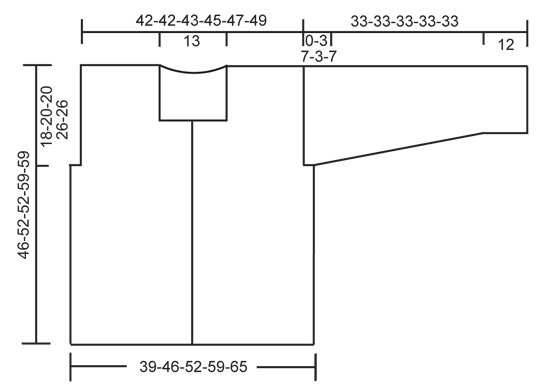
What can you do with our patterns? You can share DROPS patterns online, using the pattern original picture, materials, name and number. But you are NOT ALLOWED to reproduce the complete pattern digitally in any way. Yarn stores are welcome to use the DROPS pattern database to promote the sale of our assortment. You can print out our patterns, make as many copies as you’d like. The only thing we ask is that you don't make any changes / additions to the original printed document. And that the patterns according to the DROPS philosophy are given out to the consumers for free. Editorials that wish to publish our patterns in printed books or magazines can contact us for more information. The sale of garments based on DROPS patterns is permitted as long as they are sold as single items or per order. Further commercial use of the patterns is not permitted. It has to be clearly stated that the garment is made based on a design from DROPS DESIGN. The use of clothing labels of which DROPS DESIGN forms part is conditioned by the inclusion of the following text: “A DROPS DESIGN made by …..”. The use of DROPS photos for marketing purposes/sales is only permitted in connection with the use/sale of DROPS products. The photos may not be cut or edited and the logo should be clearly visible.
We reserve the right to withdraw the permission for use of our patterns at any time, notwithstanding the reason.
Each of our patterns has specific tutorial videos to help you.
These step-by-step tutorials might also help you:
Why is the knitting/crochet tension so important?
Knitting tension is what determines the final measurements of your work, and is usually measured per 10 x 10 cm. It is provided like so: number of stitches in width x number of rows in height - eg: 19 stitches x 26 rows = 10 x 10 cm.
The knitting tension is very individual; some people knit/crochet loosely while others work tightly. You adjust the knitting tension with the needle size, which is why the suggested needle size is only meant as a guide! You need to adjust this (up or down) to ensure that YOUR knitting tension matches the knitting tension provided in the pattern. If you work with a different knitting tension than provided you will have a different yarn consumption, and your work will have different measurements than what the pattern suggests.
The knitting tension also determines which yarns can replace each other. As long as you achieve the same knitting tension you can replace one yarn with another.
See DROPS lesson: How to measure your tension/gauge
See DROPS video: How to make a gauge tension swatch
How do I know how many balls of yarn I need?
The required amount of yarn is provided in grams, eg: 450 g. To calculate how many balls you’ll need you first need to know how many grams are in 1 ball (25g, 50g or 100g). This information is available if you click on the individual yarn quality on our pages. Divide the amount required with the amount of each ball. For example, if each ball is 50g (the most common amount), the calculation will be as follows: 450 / 50 = 9 balls.
Can I use a different yarn than what the pattern suggests?
The important thing when changing from one yarn to another is that the knitting/crochet tension remains the same. This is so that the measurements of the finished piece will be the same as on the sketch provided. It is easier to achieve the same knitting tension using yarns from the same yarn group. It is also possible to work with multiple strands of a thinner yarn to achieve the knitting tension of a thicker one. Please try our yarn converter. We recommend you to always work a test swatch.
Please NOTE: when changing yarn the garment might have a different look and feel to the garment in the photo, due to individual properties and qualities of each yarn.
See DROPS lesson: Can I use a different yarn than the one mentioned in the pattern?
What are the yarn groups?
All our yarns are categorised into yarn groups (from A to F) according to thickness and knitting tension – group A contains the thinnest yarns and group F the thickest. This makes it easier for you to find alternative yarns to our patterns, should you wish to switch yarn. All yarns within the same group have a similar knitting tension and can easily replace each other. However, different yarn qualities have different structures and properties which will give the finished work a unique look and feel.
How do I use the yarn calculator?
At the top of all our patterns you’ll find a link to our yarn calculator, which is a helpful tool should you wish to use a different yarn than suggested. By filling in the yarn quality you wish to replace, the amount (in your size) and number of strands, the calculator will present good alternative yarns with the same knitting tension. Additionally it will tell you how much you’ll require in the new qualities and whether you’ll need to work with multiple strands. Most skeins are 50g (some are 25g or 100g).
If the pattern is worked with multiple colours, every colour will have to be calculated separately. Similarly, if the pattern is worked with several strands of different yarns (for example 1 strand Alpaca and 1 strand Kid-Silk) you will have to find alternatives for each, individually.
Why do you show discontinued yarns in the patterns?
Since different yarns have different qualities and textures we have chosen to keep the original yarn in our patterns. However, you can easily find options among our available qualities by using our yarn calculator, or simply pick a yarn from the same yarn group.
It is possible that some retailers still have discontinued yarns in stock, or that someone has a few skeins at home that they would like to find patterns for.
The yarn calculator will provide both alternative yarn as well as required amount in the new quality.
What size should I knit?
If you think it's hard to decide what size to make, it can be a good idea to measure a garment you own already and like the size of. Then you can pick the size by comparing those measures with the ones available in the pattern's size chart.
You'll find the size chart at the bottom of the pattern.
See DROPS lesson: How to read size chart
Why do I get the wrong knitting tension with the suggested needle size?
The needle size provided in the pattern serves only as a guide, the important thing is to follow the knitting tension. And since knitting tension is very individual, you will have to adjust the needle size to ensure that YOUR tension is the same as in the pattern – maybe you’ll have to adjust 1, or even 2 needle sizes, up or down to achieve the correct tension. For this, we recommend that you work test swatches.
Should you work with a different knitting tension than the one provided, the measurements of the finished garment might deviate from the measurement sketch.
See DROPS lesson: How to measure your tension/gauge
See DROPS video: How to make a tension/gauge swatch
Why is the pattern worked top-down?
Working a garment top-down provides more flexibility and room for personal adjustment. For example it is easier to try the garment on while working, as well as making adjustments to length of yoke and shoulder caps.
The instructions are carefully explaining every step, in the correct order. Diagrams are adjusted to the knitting direction and are worked as usual.
How do I work according to a knitting diagram?
The diagram depicts all rows/rounds, and every stitch seen from the right side. It is read from bottom to top, from right to left. 1 square = 1 stitch.
When working back and forth, every other row is worked from the right side and every other row is worked from the wrong side. When working from the wrong side, the diagram will have to be worked reversed: from left to right, knit stitches are purled, purl stitches are knit etc.
When working in the round every round is worked from the right side and the diagram are worked from right to left on all rounds.
See DROPS lesson: How to read knitting diagrams
How do I work according to a crochet diagram?
The diagram depicts all rows/rounds, and every stitch seen from the right side. It is worked from bottom to top, from right to left.
When working back and forth every other row is worked from the right side: from right to left and every other row is worked from the wrong side: from left to right.
When working in the round, every row in the diagram are worked from the right side, from right to left.
When working a circular diagram you start in the middle and work your way outwards, counter clockwise, row by row.
The rows usually start with a given number of chain stitches (equivalent to the height of the following stitch), this will either be depicted in the diagram or explained in the pattern.
See DROPS lesson: How to read crochet diagrams
How do I work several diagrams simultaneously on the same row/round?
Instructions for working several diagrams after each other on the same row/round, will often be written like so: “work A.1, A.2, A.3 a total of 0-0-2-3-4 times". This means you work A.1 once, then A.2 is worked once, and A.3 is repeated (in width) the number of times provided for your size – in this case like so: S = 0 times, M = 0 times, L=2 times, XL= 3 times and XXL = 4 times.
The diagrams are worked as usual: begin with the first row in A.1, then work the first row in A.2 etc.
See DROPS lesson: How to read knitting diagrams
See DROPS lesson: How to read crochet diagrams
Why are the sleeves shorter in larger sizes?
The total width of the garment (from wrist-to-wrist) will be larger in the larger sizes, despite the actual sleeves being shorter. The larger sizes have longer sleeve caps and wider shoulders, so there will be a good fit in all sizes.
Where on the garment is the length measured?
The measurement sketch/schematic drawing provides information regarding the full length of the garment. If it’s a jumper or a jacket the length is measured from the highest point on the shoulder closest to the neckline, and straight down to the bottom of the garment. It is NOT measured from the tip of shoulder. Similarly, the length of yoke is measured from the highest point on the shoulder and down to where yoke is split into body and sleeves.
On a jacket measures are never taken along bands, unless specifically stated. Always measure inside band stitches when measuring the length.
See DROPS lesson: How to read a schematic drawing
What is a repeat?
Diagrams are often repeated on the round or in height. 1 repeat is the diagram the way it appears in the pattern. If it says to work 5 repeats of A.1 in the round, then you work A.1 a total of 5 times after/next to each other in the round. If it says to work 2 repeats of A.1 vertically/in height you work the entire diagram once, then begin again at the start and work the entire diagram one more time.
Why does the piece start with more chain stitches than it’s worked with?
Chain stitches are slightly narrower than other stitches and to avoid working the cast-on edge too tight, we simply chain more stitches to begin with. The stitch count will be adjusted on the following row to fit the pattern and measurement sketch.
Why increase before the rib edge when the piece is worked top-down?
The rib edge is more elastic and will contract slightly compared to, for example, stocking stitch. By increasing before the rib edge, you avoid a visible difference in width between the rib edge and the rest of the body.
Why increase in the cast-off edge?
It’s very easy to cast off too tightly, and by making yarn overs while casting off (and simultaneously casting these off) you avoid a too tight cast off edge.
See DROPS video: How to bind off with yarn overs (yo)
How do I increase/decrease on every 3rd and 4th row/round alternately?
To achieve an even increase (or decrease) you can increase on, for example: every 3rd and 4th row alternately, like so: work 2 rows and increase on the 3rd row, work 3 rows and increase on the 4th. Repeat this until the increase is complete.
See DROPS lesson: Increase or decrease 1 st on every 3rd and 4th row alternately
How can I work a jacket in the round instead of back and forth?
Should you prefer to work in the round instead of back and forth, you may of course adjust the pattern. You’ll need to add steeks mid-front (usually 5 stitches), and follow the instructions. When you would normally turn and work from the wrong side, simply work across the steek and continue in the round. At the end you’ll cut the piece open, pick up stitches to work bands, and cover the cut edges.
See DROPS video: How to knit steeks and cut open
Can I work a jumper back and forth instead of in the round?
Should you prefer to work back and forth instead of in the round, you may of course adjust the pattern so you work the pieces separately and then assemble them at the end. Divide the stitches for the body in 2, add 1 edge stitch in each side (for sewing) and work the front and back pieces separately.
See DROPS lesson: Can I adapt a pattern for circular needles into straight needles?
Why is the pattern slightly different than what I see in the photo?
Pattern repeats can vary slightly in the different sizes, in order to get the correct proportions. If you’re not working the exact same size as the garment in the photo, yours might deviate slightly. This has been carefully developed and adjusted so that the complete impression of the garment is the same in all sizes.
Make sure to follow instructions and diagrams for your size!
How do I make a women’s size garment into a men’s size one?
If you have found a pattern you like which is available in women’s size it’s not very difficult to convert it to men’s size. The biggest difference will be the length of sleeves and body. Start working on the women size that you think would fit across the chest. The additional length will be worked right before you cast off for the armhole/sleeve cap. If the pattern is worked top-down you can add the length right after the armhole or before the first decrease on sleeve.
Regarding additional yarn amount, this will depend on how much length you add, but it is better with a skein too many than too few.
How do I prevent a hairy garment from shedding?
All yarns will have excess fibres (from production) that might come off as lint or shedding. Brushed yarns (ie hairier yarns) have more of these loose, excess fibres, causing more shedding.
Shedding also depends on what is worn under or over the garment, and whether this pulls at the yarn fibres. It’s therefore not possible to guarantee that there will be no shedding
Below are some tips on how to get the best result when working with hairier yarns:
1. When the garment is finished (before you wash it) shake it vigorously so the looser hairs come off. NOTE: do NOT use a lint roller, brush or any method that pulls at the yarn.
2. Place the garment in a plastic bag and put it in your freezer - the temperature will cause the fibres to become less attached to each other, and excess fibres will come off easier.
3. Leave in the freezer for a few hours before taking it out and shaking it again.
4. Wash the garment according to the instructions on the yarn label.
Why does my garment pill?
Pilling is a natural process that happens to even the most exclusive of fibers. It's a natural sign of wear and tear that is hard to avoid, and that is most visible in high friction areas of your garment like a sweater's arms and cuffs.
You can make your garment look as new by removing the pilling, using a fabric comb or a pill/lint remover.
In the meantime, you can read the questions and answers that others have left to this pattern or join the DROPS Workshop on Facebook to get help from fellow knitters/crocheters!
You might also like...
Summer Patchwork
Crochet Cardigan
Summer Patchwork |
|
 |
 |
Crochet DROPS jacket with ¾ sleeves and granny squares in ”Alpaca”. Size: S - XXXL
DROPS 147-9 |
|
|
COLOURS ON SQUARES: Last round (= colour 4) on all squares is off white. SQUARE A: Colour 1 = lime, colour 2 = orange, colour 3 = light blue. SQUARE B: Colour 1 = goldenrod, colour 2 = light pink, colour 3 = dark pink. SQUARE C: Colour 1 = light blue, colour 2 = lime, colour 3 = orange. SQUARE D: Colour 1 = dark pink, colour 2 = light pink, colour 3 = lime. SQUARE E: Colour 1 = light pink, colour 2 = pink, colour 3 = goldenrod. SQUARE F: Colour 1 = pink, colour 2 = grey purple, colour 3 = light blue. SQUARE G: Colour 1 = grey purple, colour 2 = light blue, colour 3 = light pink. SQUARE H: Colour 1 = pink, colour 2 = grey purple, colour 3 = lime. SQUARE I: Colour 1 = orange, colour 2 = goldenrod, colour 3 = dark pink. SQUARE J: Colour 1 = light blue, colour 2 = lime, colour 3 = pink. GRANNY SQUARE: Crochet 6 ch on hook size 3 mm with colour 1 and form a ring with 1 sl st in first ch. ROUND 1 (colour 1): 3 ch, 2 tr in ch-ring, * 3 ch, 3 tr in ch-ring *, repeat from *-* a total of 3 times and finish with 3 ch and 1 sl st in 3rd ch from beg of round. Turn piece. ROUND 2 (colour 2): 3 ch, 2 tr in first ch-loop, 3 ch, 3 tr in same ch-loop, * 1 ch, 3 tr in next ch-loop, 3 ch, 3 tr in same ch-loop *, repeat from *-* a total of 3 times and finish with 1 ch and 1 sl st in 3rd ch from beg of round. Turn piece. ROUND 3 (colour 3): 3 ch, 2 tr in first ch-loop, 1 ch, * 3 tr in next ch-loop, 3 ch, 3 tr in same ch-loop, 1 ch, 3 tr in next ch-loop, 1 ch *, repeat from *-* a total of 3 times, 3 tr in next ch-loop, 3 ch, 3 tr in same ch-loop, 1 ch and finish with 1 sl st in 3rd ch from beg of round. Turn piece. ROUND 4 (colour 4): 3 ch, 2 tr in first ch-loop, 1 ch, * 3 tr in next ch-loop, 3 ch, 3 tr in same ch-loop, 1 ch, 3 tr in next ch-loop, 1 ch, 3 tr in next ch-loop, 1 ch *, repeat from *-* a total of 3 times, 3 tr in next ch-loop, 3 ch, 3 tr in same ch-loop, 1 ch, 3 tr in next ch-loop, 1 ch and finish with 1 sl st in 3rd ch from beg of round. Cut the thread. 1 square measures approx. 6.5 x 6.5 cm. Work 12-14-15-20-21 squares of every colour combination, work in addition 0-2-2-8-8 extra squares (choose your own colour combination on these squares) = 120-142-152-208-218 squares in total. SLEEVE GUSSET: Work a piece with tr shaped as a gusset to be sewn under sleeve so it is wider at the top than the at bottom. Replace first tr on every row with 3 ch. Work 7-8-8-8-8 ch on hook size 3 mm with off white. Turn and work 1 tr in 4th ch from hook, then work 1 tr in the remaining 3-4-4-4-4 ch = 5-6-6-6-6 tr. Continue back and forth with 1 tr in every tr until piece measures 10 cm. READ ALL OF THE FOLLOWING SECTION BEFORE FINISHING! On next row inc 1 tr in each side by working 2 tr in next to last tr in each side. Repeat inc every 3-2-2-2-2 rows a total of 9-12-12-12-12 times. NOTE: In size XS/S continue with 1 tr in every tr until piece measures 33 cm. In sizes M and XXL divide the piece in the middle when it measures 30 cm, then work each side separately with 1 tr in every tr until piece measures 33 cm. In sizes L/XL and XXXL divide the piece in the middle when it measures 26 cm, then work each side separately, when inc is done, with 1 tr in every tr until piece measures 33 cm. The piece is divided in the 4 largest sizes because of dec for armholes. This is not done in the smallest size. Work another sleeve gusset. Place the squares tog for back and front piece as shown on diagram – you can choose in which order you want to put the squares. Distribute the remaining 40-40-40-60-60 squares for 2 sleeves, with 20-20-20-30-30 squares on each sleeve. In the 3 smallest sizes there should be 4 x 5 squares and in the 2 largest sizes there should be 6 x 5 squares - there are 5 squares vertically in all sizes. Sew the squares tog edge to edge with off white. Sew sleeve gusset to each side of squares on sleeves and sew sleeves in body – with the widest part of gusset in the bottom of armhole. Then sew the side seams and shoulder seams the same way – NOTE: In sizes M and XXL there is 1 row with squares in the middle of each side under armhole, in sizes L/XL and XXXL there are 2 rows with squares in each side under armhole. Work around the entire jacket with off white as follows (beg mid back of neck): 1 dc in 1 ch at the edge of 1 square, 3 ch and 2 tr in same ch, * 1 ch, 3 tr in next ch *, repeat from *-*. NOTE: In the corners faced inwards work as follows: 1 tr in last ch before corner, 1 tr in the corner and 1 tr in first ch after corner. In the corners faced outwards work as follows: 3 tr in ch-loop in the corner on square, 3 ch and 3 more tr in the same ch-loop. In every corner at the top by neck also work a tie as follows: 3 tr in ch-loop in the corner on square, then work loose ch for approx. 28 cm, turn and work 1 dc in every ch on the way back, then 3 tr in the same ch-loop in the corner. Work the same way at bottom around the sleeves – over the section between the squares work as follows: * 1 tr in each of the first 3 tr, 1 ch, skip 1 tr *, repeat from *-*. |
|

|
|

|
|
|
Have you made this or any other of our designs? Tag your pictures in social media with #dropsdesign so we can see them! Do you need help with this pattern?You'll find tutorial videos, a Comments/Questions area and more by visiting the pattern on garnstudio.com. © 1982-2024 DROPS Design A/S. We reserve all rights. This document, including all its sub-sections, has copyrights. Read more about what you can do with our patterns at the bottom of each pattern on our site. |
|
With over 40 years in knitting and crochet design, DROPS Design offers one of the most extensive collections of free patterns on the internet - translated to 17 languages. As of today we count 304 catalogues and 11422 patterns - 11422 of which are translated into English (UK/cm).
We work hard to bring you the best knitting and crochet have to offer, inspiration and advice as well as great quality yarns at incredible prices! Would you like to use our patterns for other than personal use? You can read what you are allowed to do in the Copyright text at the bottom of all our patterns. Happy crafting!







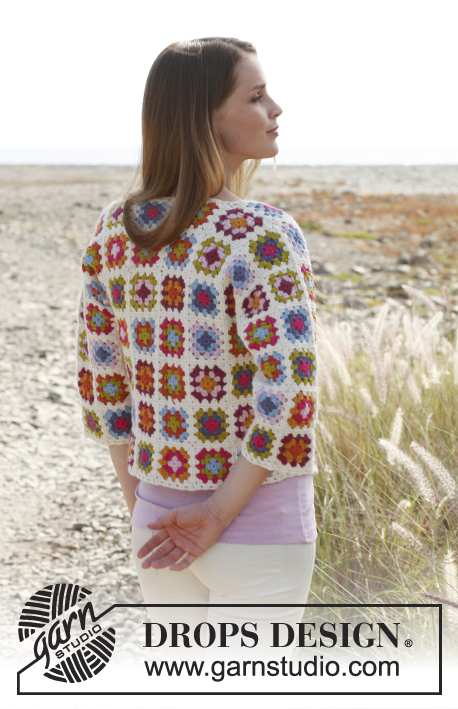



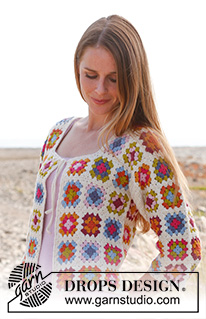

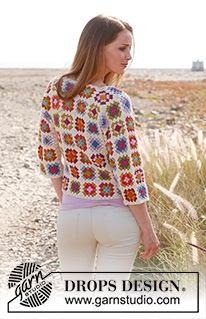




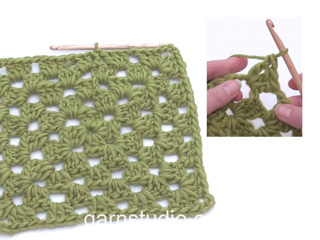

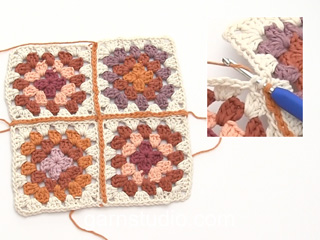
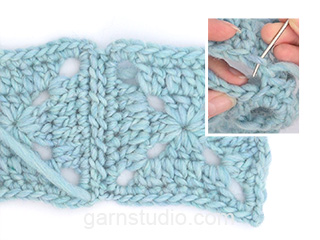
























Comments / Questions (188)
Hi. Thanks for your reply. unfortunately new to crochet and can’t picture what the gusset should look like. Is there any chance you could provide a photo, video or diagram please. Preferably with measurements of length and width. Thanks for your help. Anne
22.05.2020 - 11:46DROPS Design answered:
Dear Mrs Hansen, we do not have more than the pattern - did you already tried to? Just start to crochet following the explanations, it should then by and by have more sense. You might find more pictures of customers' projects here. Happy crocheting!
22.05.2020 - 12:38I am doing the summer patchwork cardi and have come to the sleeve gusset and I can’t figure it out. Can you help?
20.05.2020 - 22:09DROPS Design answered:
Dear Mrs Hansen, the sleeve gusset is a small piece you will crochet extra over first 5 or 6 trebles for 10 cm, then increase 1 st on each side of piece on every 3rd or 2nd row (see size) (*work 1 row inc 1 tr on each side, 2 rows without inc * repeat from *- * in first size - in other sizes *work 1 row with increases, 1 row without increases*, repeat these 2 rows. When all increases are done, continue to 33 cm in 1st size. in 2 larger sizes you will divide piece in 2 and work the 2 sides separately to make a split/vent (for the seam allowance). Hope this helps; Happy crocheting!
22.05.2020 - 08:57Ik zou graag willen weten wat het voordeel van een granny heen en weer boven een gewone granny, dus niet heen en weer, is. Wat is de voorkant bij de heen en weer granny?
17.04.2020 - 21:42DROPS Design answered:
Dag Christina Jones,
Als je een granny heen en weer haakt geeft dit een ander stekenbeeld en trekt het werk minder snel scheef. Je haakt dan afwikkelend op de voor- en achterkant van het werk. Je hebt op deze manier niet een duidelijke goede en verkeerde kant, als je alle vierkantjes maar op de zelfde manier naar de goede kant legt.
29.04.2020 - 10:06Ik wil patroon 147-9 gaan maken maar ik wil geen alpaca garen omdat hij niet vorm vast zou zijn Wat raadt u mij aan als alternatief
29.03.2020 - 21:09DROPS Design answered:
Dag Loes,
Je kan ieder ander garen uit garengroep A. nemen, zodat je dezelfde stekenverhouding hebt. (Maak wel even een proeflapje om dat te controleren. Hier vind je de garengroepen.
29.04.2020 - 10:09Maat M en XXL: splits het werk in het midden als het 30 cm meet, haak dan elke kant apart verder met 1 stk in elk stk tot het werk 33 cm meet. Ik snap dit niet zo goed. Kunt u mij hierover meer uitleg geven?
26.10.2019 - 14:04DROPS Design answered:
Dag Sanne,
Als het goed is heb je na het meerderen van stokjes in totaal 30 stokjes op de toer. Je splitst het werk nu bij een hoogte van 30 cm in tweeën door eerst steeds heen en weer te haken over de eerste 15 steken tot het werk 33 cm meet. Dan hecht je de draad aan over het tweede deel en haak je ook weer heen en weer over die 15 steken tot het werk 33 cm meet.
27.10.2019 - 16:09Non riesco a capire per il rinforzo manica taglia M cosa si intende per "dividere il lavoro al centro e proseguire separatamente", immagino che, arrivata a 30 centimetri debbo continuare lavorando con due capi in modo da avere due striscioline da 15 maglie ognuna per 3 centimetri, ma poi non capisco queste due strisce dove debbo cucirle. forse sarebbe utile una foto. grazie per la risposta
23.09.2019 - 09:52DROPS Design answered:
Buongiorno Caterina. Il rinforzo viene cucito nel sottomanica. Le due parti separate vanno cucite allo scalfo sul davanti e allo scalfo sul dietro. Buon lavoro!
23.09.2019 - 10:11I afsnittet Ærmekiler under OBS : jeg hækler xxl men kan ikke se hvordan xxl skal hækles? ( xxxl står to gange, så det er nok en skrivefejl 🤔
20.09.2019 - 22:18DROPS Design answered:
Hej Nynne, tak for info, vi skal få det rettet så det fremgår hvilken af dem som er XXL. :)
03.10.2019 - 12:02Is the 4" square including the border color?
23.08.2019 - 14:01DROPS Design answered:
Dear Mrs Segars, 1 square = 4 rounds and should measure 2½" x 2½". Happy knitting!
23.08.2019 - 14:52I am using a C hook. three rows makes 2.5 inches not 4 rows.
22.08.2019 - 19:45DROPS Design answered:
Dear Mrs Segars, Hook size is only a suggestion! If you have too many stitches on 10 cm = 4” switch to larger hook. If you have too few stitches on 10 cm = 4” switch to smaller hook. read more about tension here. Happy crocheting!
23.08.2019 - 09:05Hej igen, Min sista fråga - är det viktigt att det är En jämt antal i rutor som diagrammet visar? Jag har gjort större rutor (12x12 cm) och när jag omvandlar till strl XL blir det inte bra med jämt antal, jag hade behövt lägga till men då blir det ojämnt antal rutor? Hoppas du förstår hur jag menar :) Önskar en fin sommar.
13.07.2019 - 16:27DROPS Design answered:
Hei Ann-Li. Det er et jevnt antall ruter for å få det likt på begge sider. Om du har gjort rutene større og må bruke at ujevnt antall ruter blir det ulikt på frem og baksiden. Mvh Drops design
26.08.2019 - 11:11